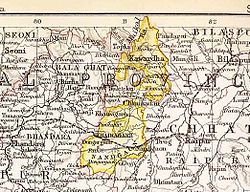Nandgaon State
| Nandgaon State नांदगाँव रियासत |
|||||
| Princely State of British India | |||||
|
|||||
|
Flag |
|||||
| Nandgaon State in the Imperial Gazetteer of India | |||||
| History | |||||
| • | Established | 1833 | |||
| • | Accession to the Indian Union | 1948 | |||
| Area | |||||
| • | 1901 | 2,256 km2(871 sq mi) | |||
| Population | |||||
| • | 1901 | 126,365 | |||
| Density | 56 /km2 (145.1 /sq mi) | ||||
| Today part of | Rajnandgaon district, Chhattisgarh | ||||
| Arnold Wright ed., Indian States: A Biographical, Historical, and Administrative Survey, Page 812 | |||||
Flag
Nandgaon State (Hindi: नांदगाँव), also known as Raj Nandgaon, was one of the princely states of India during the period of the British Raj. Nandgaon town, in present-day Rajnandgaon District of Chhattisgarh, was the only town of the state and the see of the ruler's residence.
The first ruler Ghasi Das Mahant, was recognized as a feudal chief by the British government in 1865 and was granted a sanad of adoption. Later the British conferred the title of raja on the ruling mahant.
The foundation of the estate of Nandgaon hails back to Prahlad Das, a shawl merchant who in the 18th century had migrated from the Punjab region. When he settled in Ratanpur the area was ruled by the Bhonsle clan of Marathas.
Prahlad Das belonged the Bairagi sect whose members practised strict celibacy. The word 'Bairagi' is derived from the Sanskrit Vairāgya, meaning 'freedom from passions'. Succession was ensured by chosen disciples, Chela, who became Mahants and inherited all the possessions of their predecessor. Prahlad Das became wealthy and after his death his disciple Hari Das was given power and influence by the local Maratha ruler who promoted him as his spiritual advisor. After about a century the Mahants had acquired the four parganas of Nandgaon, Pandadah, Mohgaon and Dongargaon, former feudatory estates of the Raja of Nagpur.
...
Wikipedia


